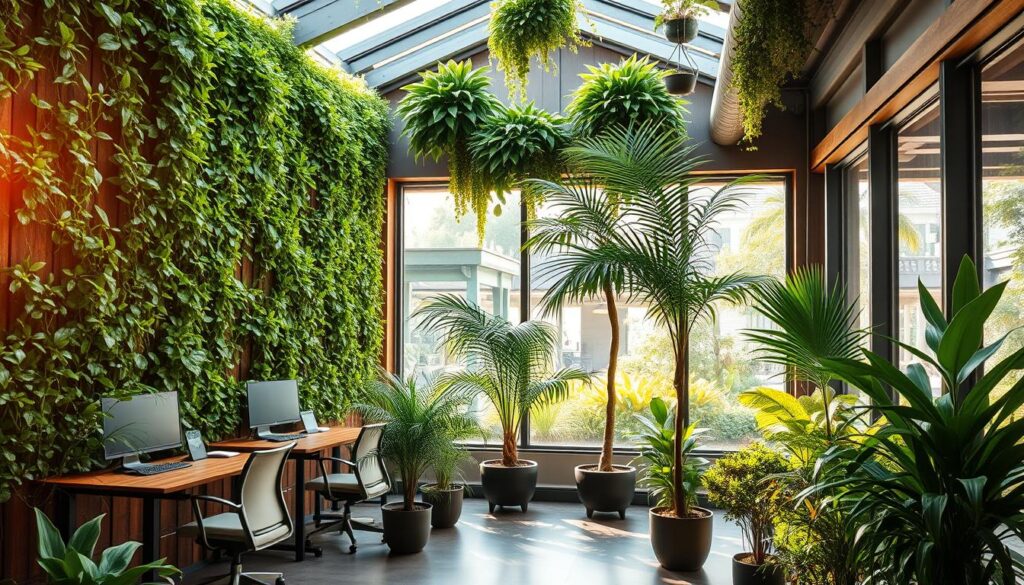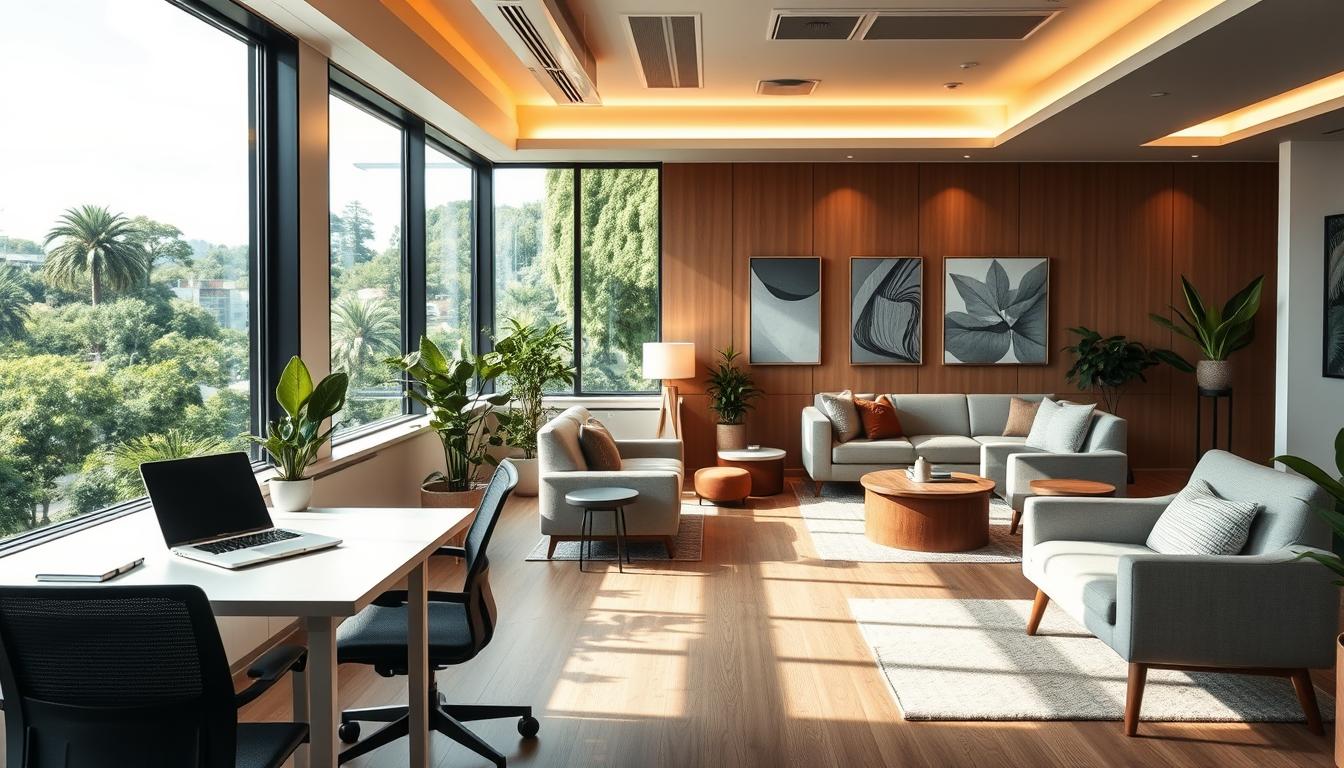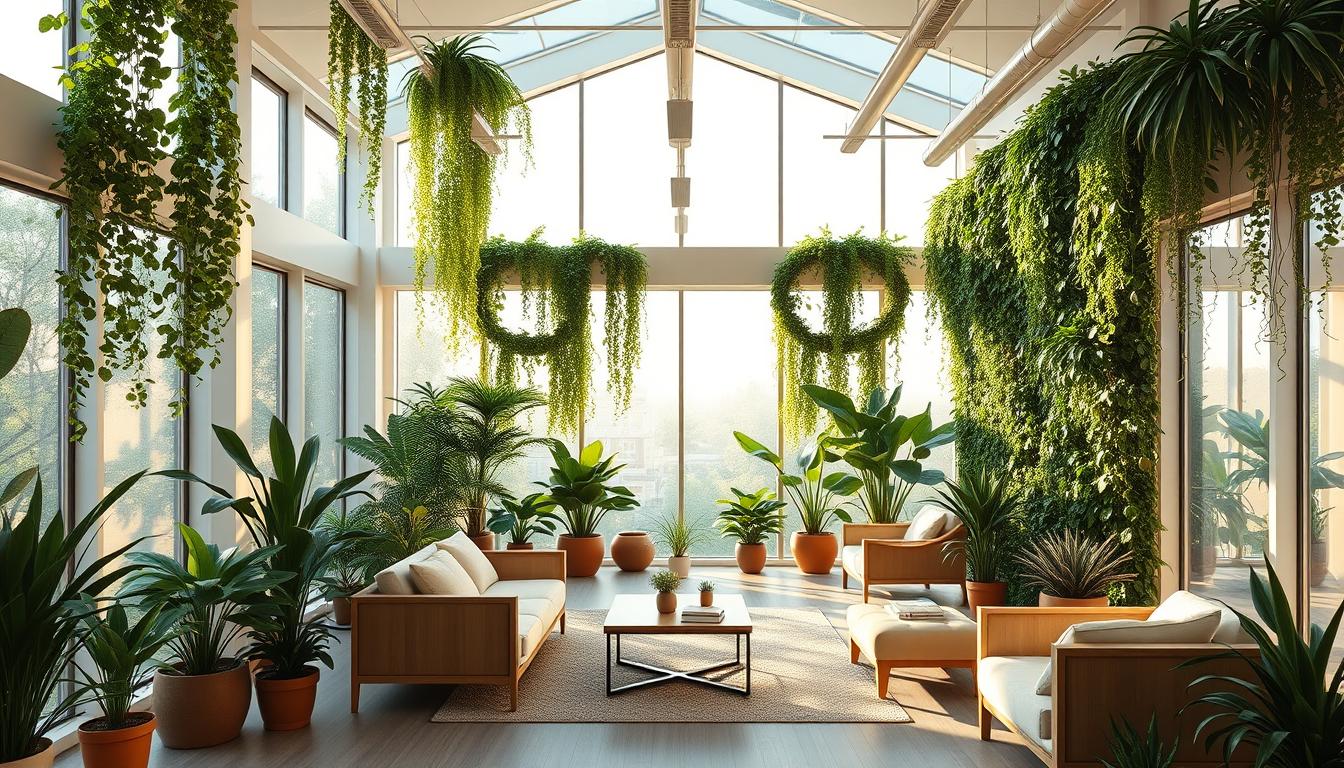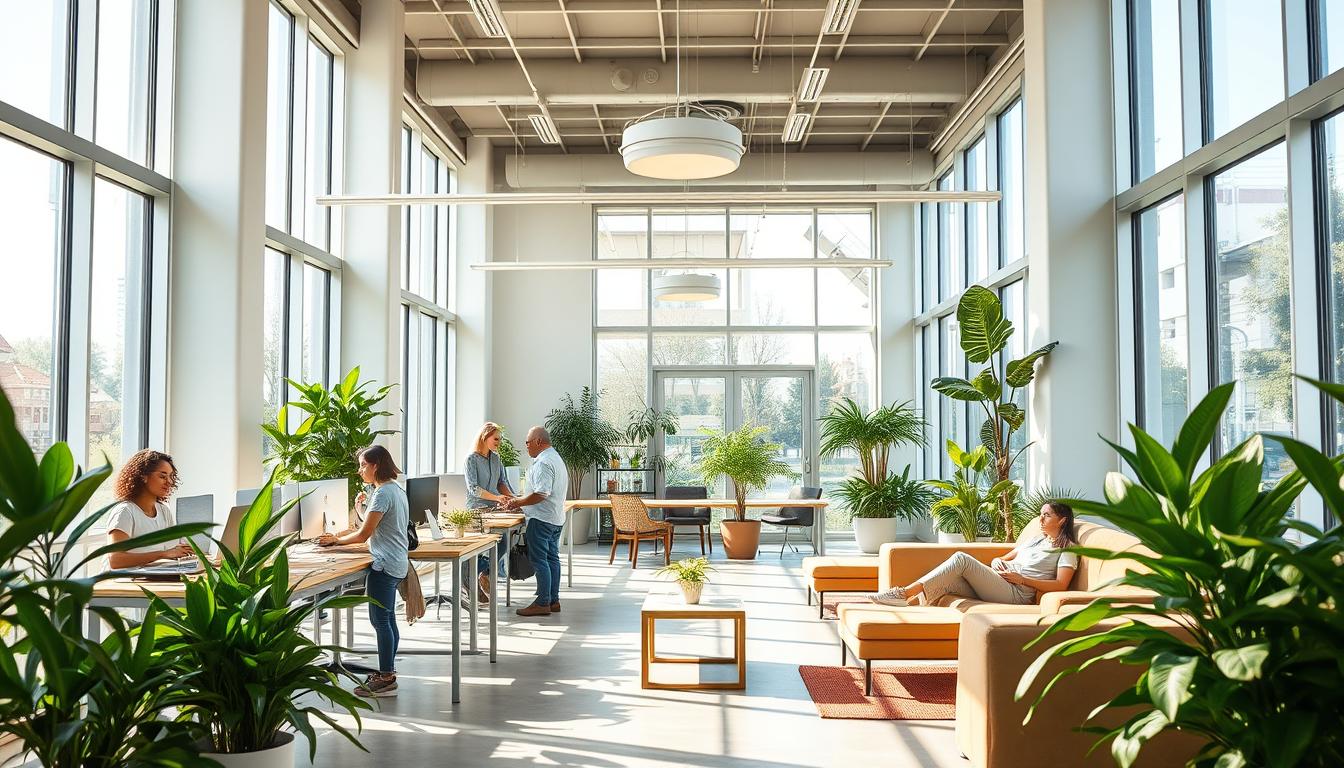In our fast-moving work life, making peaceful indoor office ecosystems is key for better health at work. By bringing in biophilic design, companies can make their spaces way better for their team. This means happier employees and more work getting done. Natural elements in these ecosystems make the air healthier and boost creativity and teamwork.
Understanding Restorative Indoor Office Ecosystems
Restorative indoor office ecosystems mix the workplace with nature, making employees feel better. This idea is key when designing office spaces. By adding plants, sunlight, and natural stuff, workplaces become nicer and more helpful.
Research shows that being close to nature at work boosts productivity by 15%. Sources like Human Spaces back this up. People work better in calm, outdoor-like settings, improving their mood and job happiness.

Building a restorative office ecosystem goes beyond beauty. It taps into how we naturally react to nature. Using biophilic design helps make offices that connect with nature. This changes plain offices into lively spots that make workdays better for everyone.
The Importance of Biophilic Design in Workspaces
Biophilic design is crucial for refreshing indoor office areas. It brings nature into work spaces, boosting employee well-being and productivity. Companies such as Google lead this trend, using natural light, plants, and open areas. This creates a calm and satisfying work environment.
Research by Harvard University and the Global Wellness Institute shows how vital greenery is in work areas. These studies reveal that natural elements don’t just make offices look better. They also uplift worker morale and boost company success. Firms that embrace greenery see more motivated employees and better staff retention.
Using biophilic design can change regular office spaces into lively and inspiring places. It sparks creativity and teamwork. The boost to mental health and work output makes biophilic design a key strategy in the present-day job scene.
Psychological Benefits of Nature in the Office
Adding nature to offices brings huge psychological perks. Studies show that green spaces and sunlight decrease stress. This makes employees healthier and more satisfied with their jobs. Putting nature in workspaces can also make people more productive. This shows it’s vital for modern office designs.
Reduction in Stress Levels
There’s strong proof that nature lowers stress. Workers in green spaces feel less anxious and tense. Natural light and plants help calm the mind, leading to relaxation. This calmness boosts daily work performance and improves staffers’ overall health.
Enhancement of Employee Creativity
Nature also boosts worker creativity. Being in natural settings sparks creative thinking. This leads to new solutions to work issues. An environment that grows creativity lets companies use their staff’s full potential. This results in innovative ideas and better business performance.
Ways to Integrate Natural Elements into Office Spaces
Making your workspace nature-friendly can boost happiness and work efficiency. Adding natural parts not only makes the place look good but also helps everyone feel better. Let’s look at how to do this in offices.
Incorporating Greenery and Plants
Bringing plants into the office changes dull areas into lively ones. You can do things like:
- Placing potted plants on desks for personal touches.
- Installing vertical gardens on walls to save space while enhancing aesthetics.
- Using larger plants in common areas to create inviting atmospheres.
Research says having lots of plants can make workplace well-being better by up to 6%. This leads to a healthier team.
Utilizing Natural Light for Improved Mood
It’s important to use as much natural light as possible. It helps make everyone feel more awake and happy. Ways to do this include:
- Designing open floor plans with large windows to allow sunlight in.
- Incorporating glass walls to promote light flow throughout the space.
- Using reflective surfaces to increase light distribution.
Airbnb is a prime model of this, with its big windows welcoming sunlight. Studies prove that good sunlight can raise work efficiency by up to 20%. So, it’s key in office design.
Case Studies of Successful Restorative Indoor Ecosystems
Exploring real-world examples shows how effective biophilic design is in offices. The Amazon Spheres in Seattle are a great case study. They have over 40,000 plants, making the area lively and green. After they added this design, employee happiness went up by 15%. This proves adding nature to workspaces has real benefits.
Google’s headquarters is another great example. Their design focuses on connecting staff with nature. They have indoor gardens, water features, and lots of sunlight. These elements follow key biophilic design principles. As a result, employees are more productive and feel better overall.
These examples show how good design and planning affect office environments. By making nature and comfort a priority, workplaces become more enjoyable for everyone.
Impact on Employee Well-being and Productivity
There’s a strong link between the great indoors at work and how well employees do. Creating a space filled with nature helps people feel better mentally. This leads to doing better work.
Improved Concentration and Focus
Offices that make you feel good help you think clearly and stay focused. Studies show people work better in places designed with nature in mind. Microsoft even saw a 20% work boost from happier employees at home. This proves that bringing the outdoors in at work makes a big difference.
Reduction in Absenteeism Rates
Offices with a touch of nature see fewer employees calling out sick. Interface saw a 43% drop in absenteeism by adding natural vibes to their space. This approach not only improves health but also cuts costs on missed days at work.
Challenges and Considerations in Implementing Biophilic Design
Bringing biophilic design into play can be tough for many organizations. It’s important to grasp these challenges to blend nature with workspaces effectively. Budget limits are a common hurdle, affecting how much can be done.
The setup that’s already in place can make adding natural touches tricky. But, it’s not just about money or space. Sometimes, people are not ready for change.
Take Google’s headquarters, for example. They faced challenges mixing modern tech with nature. Companies must find a middle ground between tech needs and natural beauty.
To overcome these obstacles, a clear plan is necessary. Start small and expand gradually. Working with green design experts can help meet both looks and efficiency targets.
Future Trends: Evolving Indoor Workspaces with Nature
Businesses are updating their indoor spaces, merging tech with nature. This link between biophilic design and modern tech helps create spaces that look good and boost productivity and well-being. Now, bringing nature into work areas is a key goal for innovation and sustainability.
Technological Integration with Natural Elements
Companies are blending high-tech with natural elements in office layouts. Smart lighting systems use natural sunlight to make workspaces calming and efficient. For example, Amazon uses technologies to control indoor climates and add more green spaces. These offices feel peaceful and connected to nature.
We’re seeing new trends like:
- Advanced temperature and humidity control for comfort.
- Indoor gardens that adjust to natural sunlight.
- Augmented reality for better interaction with nature in design.
Combining tech with nature makes offices look great and boosts team spirit. As these ideas grow, our vision of the perfect workplace changes too.
Common Features of Restorative Indoor Office Ecosystems
Creating restorative indoor office ecosystems focuses on workplace environment and employee well-being. More companies now see the value in ecosystems that love nature and sustainability.
One key feature is having indoor gardens or living walls. These bring greenery indoors, boost air quality, and make our eyes happy. Using natural materials like wood and stone is also crucial. They add a cozy feel with their natural looks and feels.
Adding water elements is another important aspect. Water brings calming sounds, helping everyone relax more. Good lighting that feels like natural light is vital, too. It helps our body clocks run right, making us feel and work better.
In short, these features make workspaces look good and feel healthy. By picking designs that cherish nature, companies meet modern goals for wellness and eco-friendliness.
Conclusion
Making offices more natural is a big step towards better health and more work done. Biophilic design, which means bringing the outside in, has many perks. It lowers stress and makes people more creative. It’s important for companies to think about this when changing their workspaces.
Adding plants and natural light makes the office look better and helps people’s minds. The way we work is changing. A workspace in tune with nature is not just a fad. It is key to making employees happy.
Restorative ecosystems do more than make the office look nice. They create a workforce that is full of energy and ready for challenges. The time to make these changes is now. It’s critical for a company’s future success.



